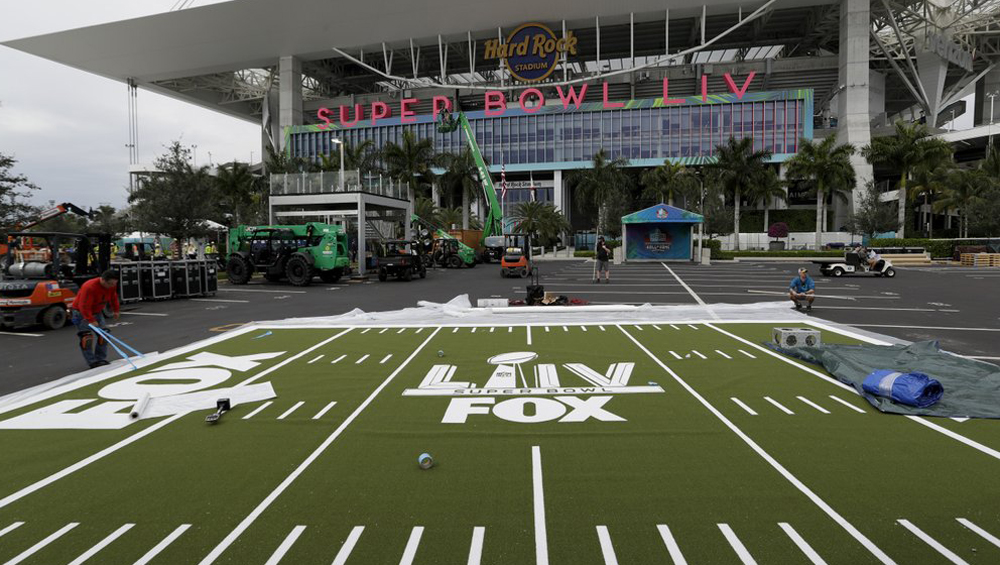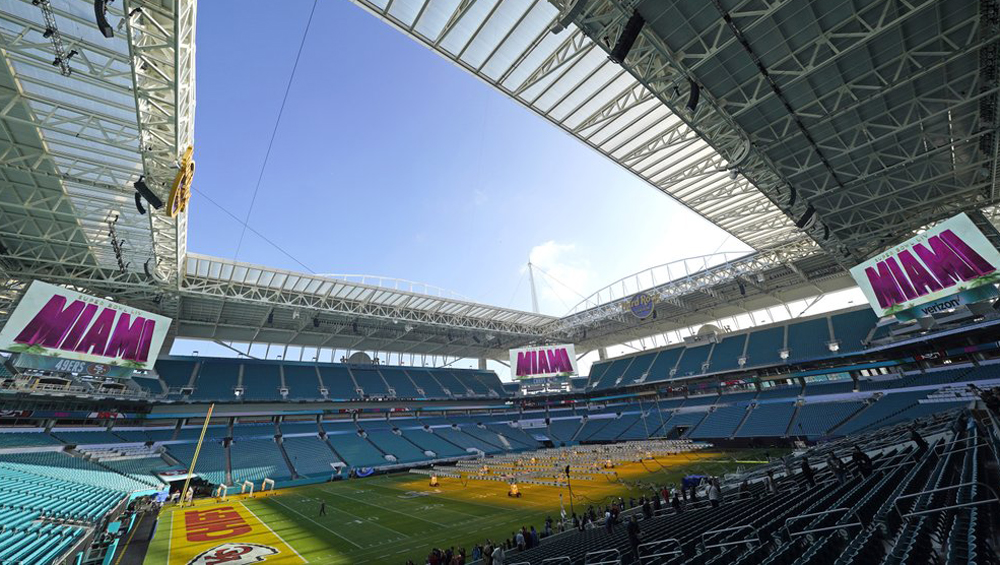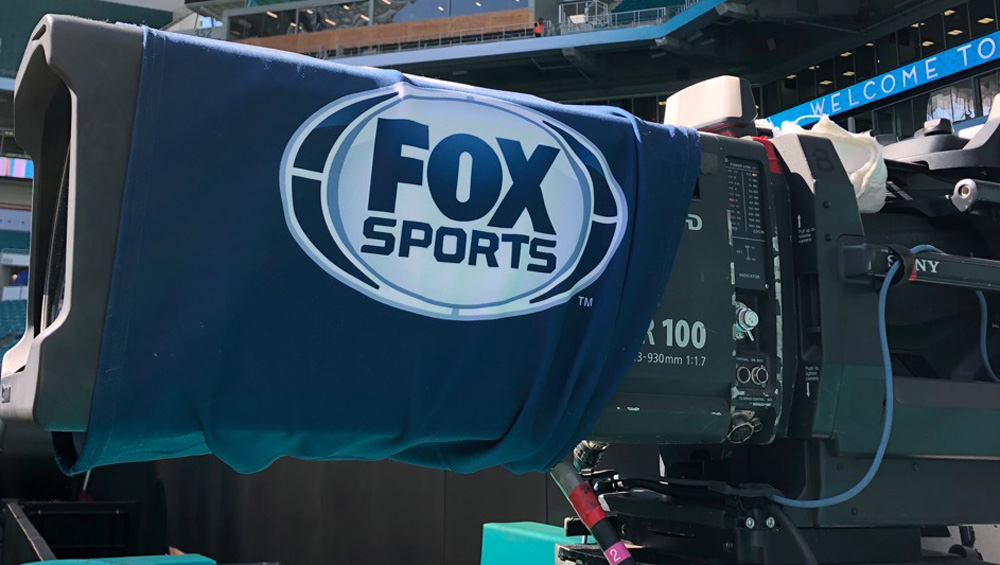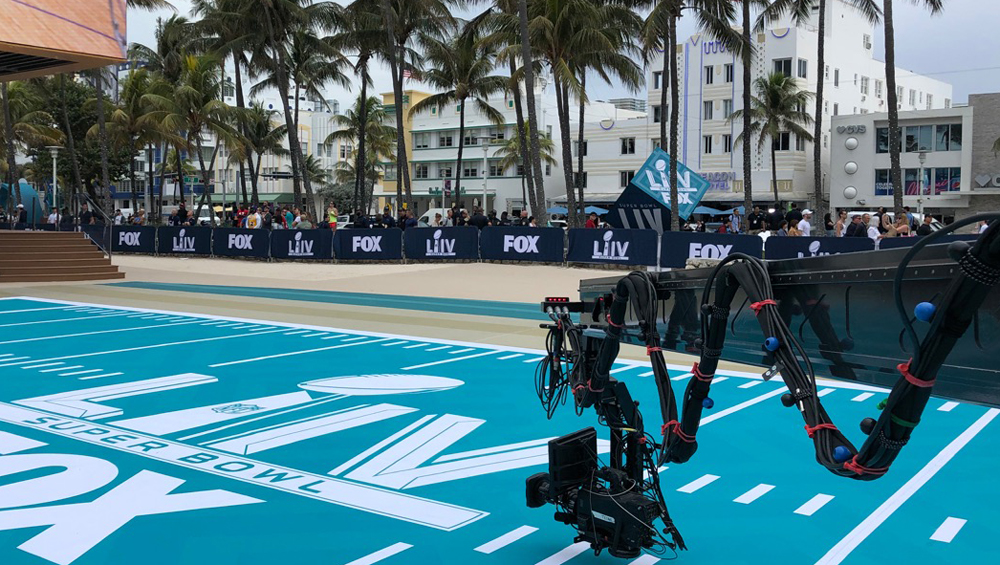
TVN Tech | Fox Tackles Monster Super Bowl Production

The scale of a Super Bowl is always massive for the network broadcasting the Big Game, but Fox is upping the ante this year for Super Bowl LIV.
The network has brought more than 1,000 people to Miami to produce over 100 hours of live coverage from two distinct locations: the game venue Hard Rock Stadium in Miami Gardens and a sprawling multi-stage compound in South Beach, some 18 miles away.
Fox Sports’ South Beach location on Ocean Drive at Lummus Park is its biggest ever for a Super Bowl and took almost a month to construct. It features two separate stages, a large demonstration field for use by weekday studio and pregame shows, 50 square meters of LED walls and over 25 cameras including multiple robotic and crane systems as well as a moveable two-point Flycam system that delivers sweeping views from the ocean to the set.
“The size of the build is absolutely enormous,” says Michael Davies, SVP of field and technical operations for Fox Sports.
The South Beach location is being used for pregame coverage throughout the week, and Fox will start its Sunday pregame show there before shifting mid-show to its “Game Day Fan Plaza” set directly outside Hard Rock Stadium. The set of the pregame show will then move again, finishing up as a sideline set within the stadium consisting of a collapsing modular stage.
The three sets are all connected by high-speed fiber, allowing for Fox to employ a “REMI” production approach for the pregame show with the producer and director operating from the main broadcast compound in Miami Gardens throughout.
The Game Day Fan Plaza set outside Hard Rock Stadium is a full set with 10 cameras, large LED screens and a demonstration field, as well as a 1,200-foot, two-point Flycam camera system than can fly over the plaza and into the stadium.
 Fox will have a total of 16 production trucks and 20 mobile offices between the Miami Gardens and South Beach locations, supported by 180,000 feet (over 34 miles) of cable and 3 megawatts of power generators. Fox’s lead game truck will be Game Creek Video’s Encore, which it has been using for its Thursday Night Football and “A” games on Sundays, while the kickoff show will be run through Game Creek’s Bravo unit. NEP is providing mobile units for the South Beach venue.
Fox will have a total of 16 production trucks and 20 mobile offices between the Miami Gardens and South Beach locations, supported by 180,000 feet (over 34 miles) of cable and 3 megawatts of power generators. Fox’s lead game truck will be Game Creek Video’s Encore, which it has been using for its Thursday Night Football and “A” games on Sundays, while the kickoff show will be run through Game Creek’s Bravo unit. NEP is providing mobile units for the South Beach venue.
Fox will use more than 100 manned and robotic cameras to cover the game, including 24 “Super-Motion” cameras to support replays; 20 goal-line and end-line pylon cameras; wireless “Line to Gain” cameras that travel up and down the field in alignment with the first-down marker; and two different SkyCam systems which operate at different elevations. It will also use 72 field mics, as well as wireless player mics, to capture game audio.
“Once again it’s bigger and better than three years ago,” Davies says. “You set the bar for the competition, and the bar will probably be raised again.”
Fox’s 1080p Play
Fox will also be raising the resolution for Super Bowl LIV, producing the game for the first time in 1080-line progressive HD at 59.94 frames per second with High Dynamic Range (known as 1080p/60 HDR) and upconverting it to 4K HDR for distribution through various cable and satellite operators including DirecTV, Dish Network, Altice and Verizon Fios (something it has already been doing for Thursday Night Football games this season).
Fox will also be streaming the game in 4K HDR through its Fox Sports and Fox Now apps, which are supported by various OTT devices including Roku and Amazon Fire TV. While Fox is producing the game using the broadcast-focused HLG (Hybrid Log Gamma) HDR format, it is streaming the game on its apps in the HDR10 format broadly supported by 4K HDR TV sets.
Of course, the overwhelming majority of viewers will watch the Super Bowl in 720p HD on the Fox broadcast network, which is part of the reason why Fox made the choice to shoot in 1080p/60 and not true 4K. Fox has done some native 4K productions in the past, including several seasons of college football and the 2019 Westminster Dog Show, and has learned a few things.
One issue with 4K, Davies says, it that at 60 frames per second the picture can suffer from motion blur when panning quickly to follow a fast-paced sport like football. But more important, the higher data rate of 4K means Fox would have to dramatically limit the number of super-slo-motion replays it could offer.
“We would have to get rid of most of the super-motion, so we wouldn’t be serving the greater audience,” Davies says.
Most production equipment like cameras and graphics systems can support 1080p HDR simply by purchasing additional software licenses. But Fox had to upgrade its entire replay server infrastructure to handle the extra bandwidth of 1080p HDR. It will use a network of 24 of EVS’ new XT Via servers, which have 10-bit codecs to support HDR and faster processing.
“The other ones can do it, but bandwidth is an issue,” Davies says. “These eliminate that issue. They’re pretty fast machines.”
Replays are the reason camera counts “skyrocket” for the Super Bowl, Davies says. When watching the live game viewers shouldn’t expect to see a bunch of new camera angles, but they can rest assured that with all of the extra sources they won’t miss anything in replay.
“Not only that you don’t miss anything, but that you have the absolute correct angle,” Davies says. “And the angle is only as good as the speed of the camera.”

Fox will employ 24 cameras with Super-Motion capability ranging from Sony multi-format cameras recording at 180 frames per second up to specialized Phantom units shooting at 1,800 frames per second. There will be eight Sony 4K cameras at the end zone, down-the-line and high end zone positions that allow Fox to shoot normally and then zoom in during replays at a magnification rate of up to 6x by taking a portion of the 4K image and blowing it up as a standard HD image. This “HD cutout” capability of the new 4K cameras has become increasingly popular among Fox and other networks in recent years, as it allows for replays from more traditional game camera positions.
“It’s sort of revisionist camera work related to replay,” Davies says.
Enter 8K
Fox will also use three Sony UHC-8300 8K cameras to augment its coverage. The 8K cameras work with Sony servers that allow operators to zoom into part of the 8K image at up to 12x and then replay it in HD. Two of the 8K cameras will be focused on the team benches and sidelines, while one will be mounted in an overhead position and will likely just be used to capture an 8K recording of the game for posterity.
Fox decided to focus the Sony 8K cameras on the team benches after a Sony 8K unit captured a unique scene from the stands during Game 5 of the 2019 World Series, when fan Jeff Adams intentionally took a home run ball off his chest so he wouldn’t spill the beers he was holding in his hands. The replay went viral and Adams, a Washington Nationals fan, became known as “Bud Light Guy” with Anheuser-Busch creating a national TV spot to commemorate the moment.
“We wouldn’t have had that except for the 8K, and that wound up being a memorable moment,” Davies says, noting he hopes to have similar luck at the Super Bowl.
Besides the Sony cameras and EVS replay systems, other key technology includes Canon lenses, Vizrt graphics, Calrec audio boards, Grass Valley production switchers and Evertz and Lawo IP-based routing systems. For augmented reality (AR) graphics, Fox will employ Epic’s Unreal Engine, which it has already been using for NASCAR coverage out of its Charlotte studios, in combination with SMT’s real-time camera tracking software.

Fox’s South Beach set’s demo field.
While Fox has enjoyed brand-new stadiums for its last few Super Bowls, it is dealing with a renovated facility in Hard Rock Stadium, which originally opened as Joe Robbie Stadium back in 1987 and has been rebranded several times. That presents some challenges, the major one being parking. The TV compound isn’t big enough to hold Fox’s entire complement of trucks and mobile offices, so Fox’s compound is bifurcated between two different lots separated by a bridge that spans an accessway.
Connecting the video equipment via fiber is relatively simple, but making sure there was adequate electricity running between the two sites was more challenging. Fox has brought in multiple uninterruptable power supply (UPS) systems to address the issue and Davies says the network may not even require any “house power” from the stadium at all.
Fox did a preseason game at the venue this summer and was able test camera positions and other details. A unique aspect of the renovated Hard Rock Stadium is its four giant spires that rise above the open-air stadium’s roof canopy to a height of 357 feet. Fox is using the spires to attach its high SkyCam, allowing it to elevate above the level of the roof and provide a unique perspective.
While Fox’s normal “low” SkyCam operates about 15 feet above the field, the high SkyCam will generally run at an elevation of 100 to 150 feet and will be used for both beauty shots and game coverage.
“We tried it on the preseason show, and it was pretty amazing,” Davies says.
The Super Bowl week brings together the various businesses under the Fox umbrella including FS1 and FS2, Spanish-language Fox Deportes, Fox’s digital properties and associated investments like Fox Bet and esports specialist Caffeine Studios. Davies says the real fun of such a big event is connecting everyone to work towards a common goal.
“When it comes to Sunday, everything is just tied in together, with everyone doing one thing,” he says.
































Comments (0)